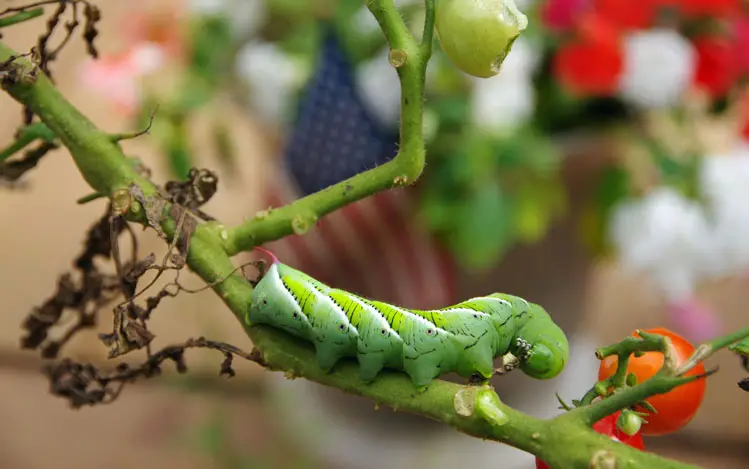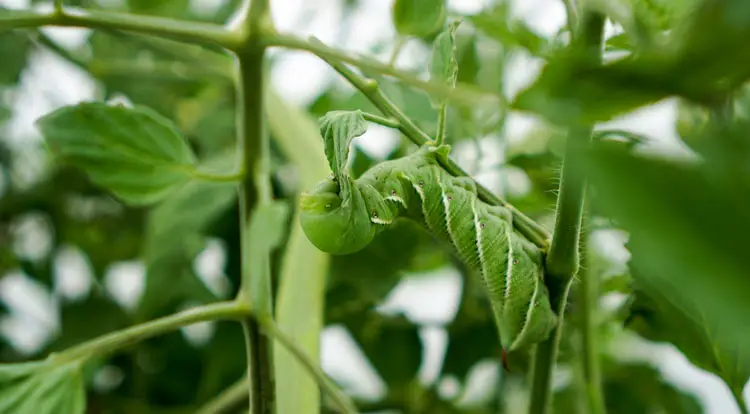Which type of worms will eat your tomato plant: How to prevent damage

This post follows our research editorial guidelines.

You aren’t the only one who loves getting their teeth into a succulent, fresh tomato. The average garden is a tempting target to all kinds of creepy crawlies keen to to take a bite out of your poor tomato plant.

Table of Contents
Which type of worms will eat your tomato plant?
At least four different species of caterpillar that eats tomato plants – the Tomato Hornworm, loopers, cutworms and army worms. They can be controlled with manual removal, or for large infestations insecticides or home remedies can be applied directly to the tomato vines.
“I often consider ignorance the most serious pest of plants,” says Clemson University entomologist Dr. Juang-Horng . With a bit of careful research and forward planning, I’ve learned to prevent pests taking a bite from my poor garden. Here’s what I’ve learned over the years – I hope it helps you, too!
The worms that eat tomato plants aren’t really worms at all. They’re caterpillars, and it’s common to see their parents flitting about outdoor lights through the spring and summer. Their eggs are tiny, often hidden under the leaves, making it hard work protecting the vine long enough to get fruit. Let’s take a look at how to identify tomato worms.
Tomato Hornworms
Tomato hornworms are a surprisingly charismatic caterpillar. They can be quite large, reaching two or three inches in length, with a bright green coloration that helps them blend into the garden. They also have stripes along their chubby little bodies that vary between species, and a horn-like growth at their back end that gives them their name.
They’re actually two different types of insect. In the northern United States, the fat stripey caterpillar dining on your tomato is likely to be from a five-spotted hawkmoth, Manduca quinquemaculata. But further south the related tobacco hookworm is more common, the larvae of Carolina sphinx moth, Manduca sexta.

Tomato Fruit Worm
These worms are often seen only as blemishes on fat, ripening fruit. Cut open the skin and you’ll see the villain – the tomato fruit worm (Helicoverpa zea). This caterpillar loves ripening tomatoes, but will also attack leaves while it waits for fruit to develop.
They’re a small worm, an inch or so in length, and in time the develop into a small plain moth with drab brown wings.
Tomato Loopers
Also known as the cabbage looper , tomato loopers are another voracious tomato pest. They rarely exceed an inch or so in length, with delicate feet at either end. Loopers are a similar shade of bright green, ideal for hiding among leaves. They move by bringing their tails up under the heads, then extending forward in a tell-tall ‘looping’movement.
Loopers are the young of the owlet moth, Trichoplusia ni. The owlet moth is migratory, moving south as the spring and summer progresses, so if you’re in the north you may find them a startling midsummer surprise.

Tomato Cutworm
Like tomato loopers, the cutworm is a tiny caterpillar that likes to nibble away at tomato stalks until the whole thing falls over – as the name suggests, they cut down the plants they devour. Young plants are especially vulnerable, with a single worm able to lop the top off a whole row of newly planted seedlings. If you’ve ever asked yourself ‘what is cutting down my tomato seedlings”, you might be dealing with cutworms.
Cutworms vary a bit in appearance, as they’re actually a few different species that all behave in a similar way. Rarely more than an inch or so long, they can be brown or green, striped or plainly colored.
Tomato Armyworm
Army worms of all kind are a real nightmare for any avid gardener. Keep an eye out for small speckled caterpillars, brown or cream, with a broad stripe that runs the length of their bodies. There’s a few different species you may be dealing with, and depending on your location you might have to do battle with these pests from spring right through to fall.
Natural ways to prevent worms from eating your tomatoes
The easiest way to deal with worms on your tomato vines is to prevent them getting a foothold in your garden in the first place.
Most worms will happily dine on common garden weeds, like nightshade or jimsonweed. By keeping weeds under control you’ll have far fewer of the moths to start with.
It’s also common for tomato worms to overwinter in the soil as pupae, the stage of development between caterpillar and moth. I turn the soil thoroughly between crops to kill any lurking pests.
But if you’ve had tomato worms latch onto your vines regardless, it’s often easiest to just pop them off as soon as you see them. Check twice a week through the spring and summer, removing them as you go. If your tomato patch is not overly large, you can often just remove them by hand. A forceful spray in the mornings with a garden hose while watering can help, too.
You can also use a tincture of garlic and chilli to keep them in check. Some like to dust chilli or garlic powder directly onto the leaves, or to make a spray from a teaspoon of chilli and garlic steeped in a gallon of warm water. Sprayed directly onto the plant, the spices damage the worms’ delicate skin and act as a deterrent.
Can I spray my tomato plants with soapy water?
It’s perfectly safe to spray your tomato vines with soapy water, provided you use the right soap Not all are the same, and some will harm your plant. It’s important to know the difference!
Never use dish soaps like Dawn, as they can strip the leaves of their protective coatings. Castille soap is better, but the best of all are purpose made horticultural soaps . They’ll kill off insect pests without damaging the tomato vines themselves.

Identifying tomato worm damage
Take a good look at your leaves, stems and new shoots. Leaves are often nibbled from the outside inwards. Hornworms especially produce distinctively gnawed looking edges, almost lacy or scalloped. Smaller worms like loopworms will leave holes
The most clear sign that your damage is caused by worms is frass, pellet or grain like droppings left after a big meal. Hornworm frass can be astonishingly large, boxy pellets that can be as large as a lentil or split pea. Smaller worms leave smaller frass, often resembly grit or dirt on tomato leaves or the ground at the base of your vine.
Can you eat tomatoes damaged by worms?
There’s no fast or easy answer as to whether or not a tomato damaged by a worm is edible. Certainly tomatoes attacked by tomato fruit worms are going to be very unappealing, riddled with holes and rotten areas.
That said, I’ve often shared half a tomato with a garden pest, cutting away the damaged fruit. It all comes down to how desperately you want that tomato!
Tomato worms are a common but easily controlled pest. With a bit of forethought and careful attention, it’s easy to learn how to prevent tomato worms destroying your garden and enjoy ripe, red tomatoes all summer long.

Before you go!
How to Propagate Elephant Ears: 7 Easy Steps
7 Common Peace Lily Problems And How To Fix Them
How Long Does a Tomato Plant Live?
Air Plants In Bathrooms: Good or Bad Idea?